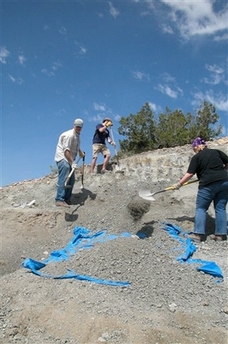Study: Dinosaurs, ancestors coexisted
(AP)Updated: 2007-07-20 11:27
WASHINGTON - Dinosaurs shared the Earth for millions of years with the species that were their ancestors, a new study concludes. Dinosaurs arose in the Late Triassic, between 235 million and 200 million years ago, and came to dominate the planet in the Jurassic, 200 million to 120 million years ago.
 This handout photo provided by the journal Science shows excavating to remove the rock that overlies the fossils ? this rock is called the 'overburden, ' above the Hayden Quarry in New Mexico, [AP]  |
Now, researchers report in the journal Science they have evidence from northern New Mexico that dinosaurs and their precursor species coexisted for tens of millions of years.
Matthew T. Carrano, curator of dinosauria at the Smithsonian's National Museum of Natural History, said there has been a long-standing debate over whether dinosaurs replaced earlier species gradually or suddenly.
"What they have is a snapshot of the transition, and it's clear there is a persistent environment with dinosaurs and these other older animals. So, at least in this place in the southwestern US, it was not abrupt," said Carrano, who was not part of the research team.
"Finding dinosaur precursors ... together with dinosaurs tells us something about the pace of changeover. If there was any competition between the precursors and dinosaurs, then it was a very prolonged competition," Randall Irmis, a graduate student at the University of California, Berkeley and co-author of the report, said in a statement.
The team reported finding 1,300 fossil specimens, including several complete bones, at Hayden Quarry at Ghost Ranch, an area made famous through the paintings of Georgia O'Keeffe.
There were no complete skeletons, and researchers are continuing to work at the site.
Their finds included bones from both early dinosaurs and dinosaur precursors as well as remains of crocodile ancestors, fish and amphibians, all dating between 220 million and 210 million years ago.
Included were leg bones of the carnivorous Chindesaurus bryansmalli, a close relative of the Coelophysis, a well-known Triassic dinosaur. They said both walked on two legs, reminiscent of the much later Velociraptor depicted in the film "Jurassic Park."
They also found remains of a Dromomeron romeri, a relative of the 235 million-year-old Argentinian middle Triassic precursor called Lagerpeton. Dromomeron was between three and five feet long, the authors concluded.
Another discovery was an unnamed, four-footed beaked grazer about three times the size of Dromomeron, they said.
The research was funded by the National Geographic Society, the Theodore Roosevelt Memorial Fund and the Jurassic Foundation.
|
|
|
||
|
||
|
|